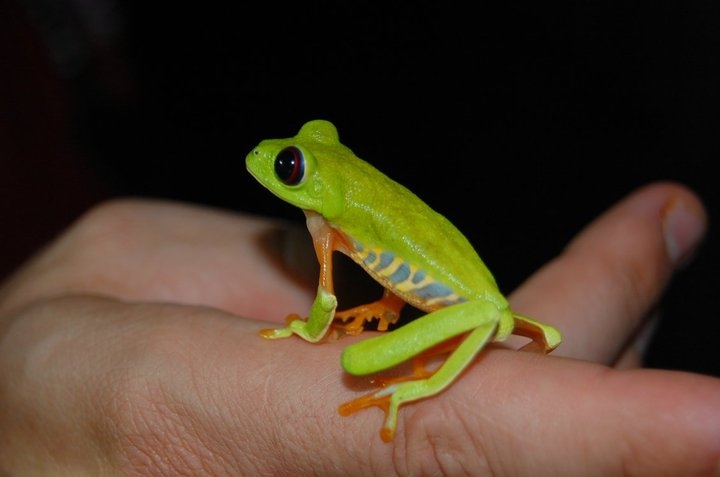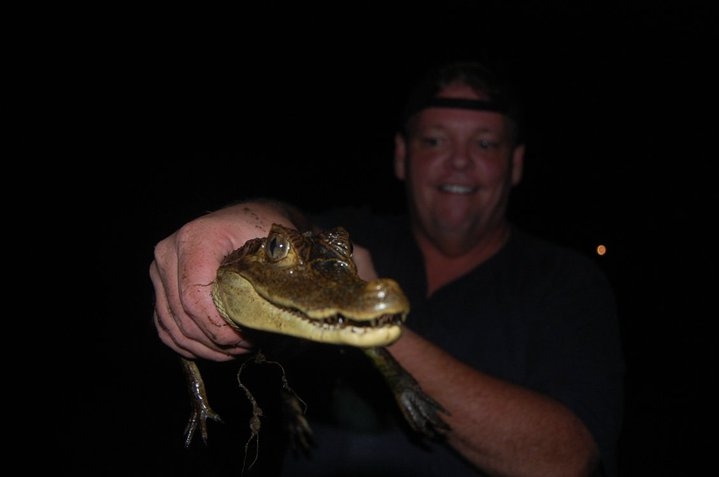Smithsonian’s National Zoo biologist Matt Evans talks about what it’s like to care for Panama’s national animal.
Tag Archives: Smithsonian’s National Zoo
Jeff Coulter: Confessions of a Frog Volunteer

As a volunteer for the rescue project, Jeff Coulter helped both to care for frogs at Summit Zoo and to build the second rescue pod.
Author Ralph Charell once said: “Nobody exceeds his or her wildest expectations unless he or she begins with some wild expectations.” I think that nicely sums up my recent trip to Panama as a volunteer with the Amphibian Rescue and Conservation project. To be candid, my expectations ranged from the mundane (constant cage cleaning) to the extravagant (finding a Panamanian golden frog in the wild). So by the time I got to Gamboa, I had no idea what to expect.
To try to share everything that I experienced in my eight days as a volunteer would fill up a number of blog posts, so I will try to stick with the highlights.
Building Frog Habitats: Sounds mundane and routine…is mundane and routine. And that’s how I thought about it at first. But the more I thought about it, the more inspired I became. Sure it’s not the most exciting work around, but just about the time I thought I would hate doing it, I realized that I hated the fact that it needed to be done even more. The project’s goal is to establish an amphibian ark where scientists can maintain healthy, genetically diverse populations of priority species. At one time Panama had more than two hundred species of frogs. Twenty-five of those have already gone extinct and as many as half of the rest are on the verge of extinction. If by hanging lights, and building cage bottoms I could play even a small role in helping keep a species from going extinct, I was more than willing to do whatever was necessary.
Spot Checks: The project has a number of employees who really give from the heart, but there is so much to do each day! On a couple of occasions I was able to pitch in and help them get through the tasks at hand. Each day every frog is visually checked, his or her cage is cleaned, and on certain days vitamins and minerals are provided to keep the frog healthy. This is in addition to the days when all the greenery in the habitats is checked or replaced. The job sounded easy at first. Spot the frog, look it over, clean out the frog poop. Sounds simple right? Now factor in the fact that these frogs are great at hiding and jumping and it suddenly becomes a much more complicated task! It seemed like I usually used one hand for keeping the frog in the enclosure, one for cleaning and one on standby in case my first hand failed (which it did a couple of times). You never knew you had three hands until you are taking care of frogs!
Frogging: I was fortunate to be in Gamboa at the same time as project international coordinator, Dr. Brian Gratwicke, and Lindsay Renick Mayer, public affairs specialist for the Smithsonian’s National Zoo and all around frog-lover. So several nights we went out frog hunting. Frog hunting in the Panamanian rainforest often involves tramping around in the middle of marshes at night, wearing a tiny head lamp and trying to track down the call of one frog in the middle of a full-scale frog opera. Did I mention I am afraid of snakes? I did think to mention it when we were ankle deep in a marsh and Brian’s sound advice was: “Then try not to step on one.”
I am an interpreter in the Amazonia Exhibit at the Smithsonian’s National Zoo, so I have had the opportunity to learn a lot about frogs and enjoy talking to guests about them. There is a massive difference between pointing out frogs in a tank and chasing a one-inch frog through a marsh at night while your frogging team keeps yelling: “Don’t let it get away! Grab it, grab it!” It’s a whole new level of learning, let me tell you. It was an amazing opportunity to catch, photograph, learn about and release the frogs back into the wild. Along the way I learned more about their behaviors, calls and needs, which is all to the good.
Not just about frogs: When I first filled out my volunteer application I was convinced I would not be selected. I didn’t really have any animal husbandry background and my Spanish skills were limited, at best. What I learned is that the project needs people with all sorts of different skills–and skill levels–and that all you really have to have is a love of frogs. But the trip wasn’t just about frogs. It was also about people and cultures and sharing, learning and laughing. One evening after we finished working I was invited to visit the village of one of the project staff. Lanky is a member of the Wounaan tribe, a group of indigenous people who live along the Rio Chagres and it was a great honor to meet his family and see the combination of traditional lifestyle and forward thinking that this family group embraces. Their thatched platform homes are very traditional, but use solar panels for lighting and electrical needs.
All of the staff made me feel welcome and actively contributed to my somewhat improved Spanish. While we couldn’t always communicate in long sentences, we could always find a way to get our meaning across and a smile is a language unto itself!
Would I recommend it? How could I not? The phrase “life-changing” may sound cliché, but in this case is perfectly accurate. It’s an opportunity to make a real difference in a fun, beautiful, exciting and sometimes challenging environment!
—Jeff Coulter is a volunteer at Smithsonian’s National Zoo.
Interested in volunteering for the Panama Amphibian Rescue and Conservation Project? Apply now!
Frog Husbandry: The Recipe for Success
Picture this:
It’s dinnertime in Panama and the Summit Zoo Diner is a-hopping: frogs of different colors and different sizes line up to receive their three-course meal after tucking in their plastic bibs. They start with an appetizer of delectable springtails, wriggling to perfection. Then it’s on to the main course of live crickets, grown to size. This is all followed by dessert—recently bred fruit flies—served à la carte. When the frogs return to the perches on their leaves, their bellies are full and they have smiles on their faces.
So the bibs and smiles might be a stretch, but the end goal is the same for the Panama Amphibian Rescue and Conservation Project—to design a menu for each individual frog in captivity that ensures the frog will eat and thrive in its new home. Food preference, however, is only one of many variables that make feeding complicated. A dedicated team of frog whisperers—animal detectives who study the individual frogs to learn their unique habits, quirks, fears and needs—must consider the differences between frogs based on species, gender, age and size to plan the perfect menu.
“The frogs’ perception of the world is, in many aspects, at least as subtle as our own,” says Ed Smith, a biologist at the Smithsonian’s National Zoo who visited the Summit Zoo in Panama City, Panama, earlier this year to help develop husbandry protocols with project researchers. “These are living things and we all perceive the world in a special way; in a very particular way.”
Because many of the priority rescue species haven’t been studied extensively in captivity, project researchers start to learn about what the animals prefer to eat by providing the food that works for species that are closely related. They take into account the frog’s age and size, whether the frog will eat food its own size or items far smaller, if it’s nocturnal or active during the day, if it eats a big item once in a while or snacks on tiny treats throughout the day.
There may also be distractions that affect appetite, including environmental or social conditions: perhaps it’s too warm or too dry, maybe mating takes priority over food, or avoiding a suitor or a combative neighbor is keeping meals a secondary concern. Frogs can be finicky eaters—one might prefer springtails and soil mites to fruit flies and crickets, or grasshoppers, earthworms, or baby mice. Sometimes researchers can determine these traits only through trial and error. And tadpoles present their own challenges—a frog in the larval stage will eat entirely different food as the same frog as an adult.
The rescue project also has to look at external factors that could stress the frogs, causing them not to eat. This includes the design of each aquarium. “If I plucked you from your home and put you into a sterile cube of white walls with a white bottom and white ceiling and then all of the sudden dropped a hamburger in there, even an avid burger fan might not feel like eating,” Smith says. “You might want to make it look and feel more like home in order to reduce stress. A couch would be nice. A kitchen table wouldn’t be bad. Maybe a little bit of air conditioning.”
To give the aquariums a more natural feel, they are outfitted with plants and rocks that are put through a rigorous cleaning process so that the tanks remain biosecure. Animal keepers carefully monitor the temperature, humidity, water and light. Even the time of day that the auto-misters come on matters—baby crickets get stuck in water and die before the frogs can eat them, thus leaving cricket-loving frogs without breakfast, Smith says.
Focusing on the frogs is only the first part of the husbandry. To keep the frogs alive, the rescue project has to keep the frogs’ food alive and make sure the insects are reproducing. This can be especially challenging when crafty pests are after the same food, temperature plays a role in the success of breeding, and permits and documents needed to bring insect soufflé in take time to process. Some of the food stuff is collected out in the field, where researchers and volunteers use nets to sweep up what they can and pull out potential sustenance.
One little La Loma tree frog in captivity refused to eat for about a week and it wasn't until the lights went out that Smith and other rescue project members were able to solve the mystery. (Photo credit: Brian Gratwicke, Panama Amphibian Rescue and Conservation Project)
Sometimes, even after all of these factors are taken into account, a frog or two still refuses to eat for mysterious reasons. Such was the case for one little La Loma tree frog (Hyloscirtus colymba) during Smith’s time in Panama. It wasn’t until the lights had gone out that Smith and another worker noticed a stream of ants pour out of a piece of bamboo the frog used to perch on. According to Smith, the frog cowered in the corner as the ants raided its food. Although the project team had cleaned the bamboo, the ants were hiding securely between bamboo nodes.
“The name of the game is husbandry,” Smith says. “And husbandry skills are entirely about paying attention to the organism. The people I met who are involved with the project pay an amazing amount of attention to each individual animal. They know their frogs not just as a species, not as male or female, or as a number in a book. They know all of those things, of course, but they know them each as an individual. Serving dinner is relatively easy. Ensuring that it is eaten, however, is often achieved only with that level of understanding.”
—Lindsay Renick Mayer, Smithsonian’s National Zoo


